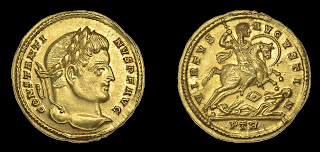The original Italo-Byantine artworks were religious icons, primarily of the Madonna and Child; small framed works, often with a golden background. The term is also applied to some architecture, and is apparent in a few very old structures, such as San Marco in Venice.
Whence came this influence? You may remember recently this post that discussed the presence of Byzantines in parts of Italy. Emperor Constans II had moved his headquarters to Sicily in the 7th century, and although the following emperors remained in Constantinople, there was still a lot of Greek culture and cultural influences in the middle part of the Mediterranean.
Although the 7th century influx of Byzantine influence in Sicily and southern Italy may have hung around until the 13th century, there was a later event that brought a larger influx of Byzantine artistic influence to the West. I'm talking about the Fourth Crusade and the events of 1204.
Called by Pope Innocent III, it did not attract as much excitement as he would have liked. Saladin had reconquered Jerusalem, and the Third Crusade had barely finished, so enthusiasm for the Crusades was waning. One result was a lack of donations to finance the venture. One must plan ahead, however, and so six envoys were sent to Venice to discuss arrangements for ships to transfer thousands of men, their horses, and supplies across the sea to the Holy Land. What these envoys did not know, of course, was how much (few) the donations were back in England and France.
It is fortunate for us that one of the envoys was a literate man who wrote a detailed account of the negotiations (after the fact, so we have to question how faithful he was to his own part in everything, once he knew how badly things had gone). He, and why the Fourth Crusade was crucial to bringing Byzantine art to Western Europe, will be a subject worthy of a few entries, starting tomorrow.



















